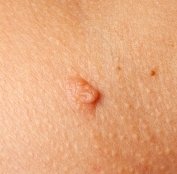A skin wart occurs when areas of the skin grow faster than normal. What causes warts is a virus known as human papilloma virus (HPV). Warts are skin-colored and are rough to the touch. They can grow almost anywhere on the body, but are most common on the hands, face and feet. There are more than 40 different types of the HPV virus.
Skin warts are contagious and children seem to be most susceptible to them. Warts can be passed by direct contact, or indirectly when both people are in contact with the same surface, such as the floor or a table. An infected person can also transmit it to other spots on their body.
A wart’s appearance can vary depending upon its location, and which of the HPV viruses caused it. As an example, flat warts are smaller and are less rough than hand or foot warts. Flat warts usually occur on the face, chest, neck, forearms and legs.
Warts are not cancerous, but are uncomfortable and embarrassing to have. They can be very itchy, and can bleed if irritated. If irritated the skin around them can become very painful.
We have been recommending a skin wart removal product for several years. It will produce noticeable results in as little as 12 hours, and helps to build up your immune system to reduce the chance that the warts will return. For more information on the best wart treatment, follow this link to H-Warts.
For additional information on types of warts and wart removal, please continue reading.
Types Of Warts
Now that we have gone over what causes warts, we will go over the different types of warts. The most often seen types of warts are:
Common warts – have well-defined borders and a rough surface. They can be either round or irregular in shape. They usually range from 2 – 10 millimeters wide. Common skin warts are either yellow, light gray, brown or gray-black, and are firm to the touch. They normally appear on the back of your hands, or near the fingernails. They are also found on the elbows and knees. Common skin warts usually are not painful.
Plantars wart – appear on the soles (bottom) of the feet. The pressure of walking or standing on them flattens them. They can be dotted with very small, clotted blood vessels that look like dark pinpoint spots. Plantar warts usually are painful, particularly when they are on a weight bearing part of your feet. Sometimes plantar warts are confused with corns. Corns though, do not have the dark pinpoint spots.
Genital warts– appear on and close to the genitals. They can also appear inside the vagina and on the cervix.
Now that we have discussed the types of warts, and what causes warts, its important to go over wart removal.
Wart Treatment
Potential wart removal techniques include freezing them, cutting them or burning them off. However these treatments are very expensive, and can lead to permanent scarring or disfigurement. Since a virus is what causes warts, there is no guarantee the warts just won’t grow back.
There is a much safer and more effective alternative for wart removal. This treatment not only eliminates current warts, but also helps to prevent future outbreaks. For more information on permanently eliminating skin warts, follow this link to H-Warts.
If you have any question about the types of warts or what causes warts, please contact us. If you have a wart removal treatment and you want our opinion, please let us know.
Additional Reading:
Causes of warts – Information about the human papilloma virus (HPV), which is what causes warts. Learn about wart removal, including the best wart treatment.
Home remedy for wart – Some of the home treatments we cover include duct tape and warts and the zinc wart cure. We don’t recommend home remedies to treat a skin wart, however, some people have has success using duck tape and warts.
Some of the recent pages we have added include treating a wart on fingers and warts on hands. If you need to see what genital warts look like, our genital warts pics page has several close up pics of genital warts. We also have pages on the genital wart symptoms, how to cure genital warts, and the best genital warts medication.
More than Skin Wart Information on our Healthy Skin Guide Home Page
